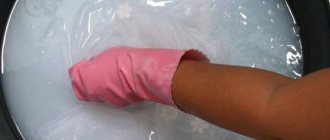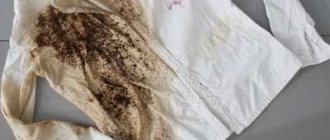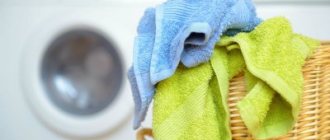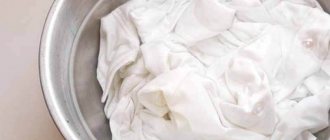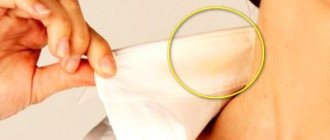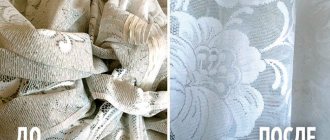The language of color is great and multifaceted. Despite the apparent complexity, the basic symbolism of flowers is clear to everyone. Red, for example, has represented fire, rage, leadership and passion since ancient times. Yellow is the sunny color of hope and imagination. Blue expresses honesty, loyalty and freedom. However, the most versatile color of all is white. It symbolizes calm, cleanliness, silence and occupies an important place in the interior and wardrobe of an ordinary person.
The nature of white color is very contradictory: it is bright and at the same time restrained. White goes well with all representatives of the color spectrum, making them brighter and more saturated. Nevertheless, every housewife knows about the fragility of these properties. Frequent use and improper care of white clothes often lead to color distortion. And returning fabric to its former whiteness is not so easy. In this case, there are always all kinds of modern bleaching products, which are not always safe for fabric.
How can you bleach fabrics at home without using advertised chemicals? This article presents proven methods for each type of fabric. Before you begin, you should carefully examine the composition of the fabric indicated on the label.
How to make gray things white?
If you need to bleach grayed items, salt is used in combination with hydrogen peroxide, baking soda, ammonia or boric acid. Sodium chloride enhances the effect of these bleaches.
Interesting materials:
How to block incoming notifications? How to book airplane seats electronically? How to set line spacing in CSS? How to seal plywood joints on a wall? How to repair cracks in plaster on a ceiling? How to prepare champignons for future use? How to prepare cauliflower for winter freezing? How to download games on xbox 360? How to upload a backup to WhatsApp? How to download all photos from the site?
Chlorine-based products
All such products are available only in liquid form. There are about thirty types of chlorine bleaches on the market in the CIS countries, the most popular of which are:
- "White";
- "Santex"
- "Ace";
- "Mitsuey" (not to be confused with fabric softener of the same name)
The chlorine present in their composition can discolor ink on any type of fabric. To bleach black fabric , you need:
- dilute 10-15 ml of bleach per 10 liters of water;
- place the fabric in the container so that it is completely hidden in the bleach;
- boil until the desired result is achieved, but not less than an hour.
In the same way, you can clean the item from contamination. But you don’t want the liquid to discolor the fabric when removing the stain, ? The concentration of the solution should be approximately 10-15% less than indicated on the package, and it should be boiled for no more than an hour and a half.
Special bleaches
There are different types of chemical bleaches. The choice of one of them is carried out depending on the intensity of pollution and the desired effect.
Optical
The active particles of such products settle on the fabric fibers, changing their color. They are able to reflect light, which visually gives the product freshness.
However, optical preparations do not eliminate stains, but only mask them.
Therefore, such products are used to refresh the whiteness of the fabric or in the presence of stains that cannot be removed by other methods.
Oxygen
When such a composition is dissolved in water, its granules disintegrate into soda and active elements. During this reaction, oxygen is released abundantly. It activates the oxidation process, which removes contaminants. The fabric brightens, streaks and stains disappear. Such bleaches can be used on any fabric; they practically do not cause allergies.
Chlorine bleaches
Such products not only eliminate yellowness and return fabrics to their original white color, but also disinfect clothes. However, chlorine is a toxic substance, so after bleaching the fabric must be rinsed several times and then washed.
Here are a few “folk” recipes for soaking
- Dissolve lemon juice and/or white vinegar (2-3 tablespoons) in 5 liters of warm water. In case of severe dirt, yellowness or gray deposits, the concentration can be increased: 1 tbsp. add a spoonful of powdered citric acid or a glass of lemon juice to 3 liters of hot water.
- Dissolve hydrogen peroxide in warm water in the proportion of 1 tbsp. spoon per 1 liter of water.
- Dissolve baking soda in warm water in a ratio of 2 tbsp. spoons of soda per 1 liter of water. Add 1-2 teaspoons of ammonia.
- Soak clothes and leave for 2-3 hours or overnight. Afterwards, wash with the addition of washing powder or gel. Rinse in water with added blue.
- Duru soap whitens well. The items are immersed in warm water, wrung out, rubbed with Duru soap, left to bleach for 30-60 minutes, then washed normally. To enhance the snow-white effect, you can add blue to the rinse water.
- An excellent result is obtained when bleaching with chlorine (except for synthetics, silk, lycra, lace). Usually in everyday life “Whiteness” is used. In order not to spoil the item, you must adhere to the proportions when preparing the solution (2 tablespoons per 10 liters of water), monitor the water temperature (no more than 40 degrees), as well as the soaking time (no more than an hour).
Important! Washable at 30-40°C; - do not tolerate spinning and drying in a washing machine; - resistant to bleach; - do not shed
Basic washing rules
To prevent an item of a contrasting color from fading, you will have to wash it by hand, carefully, avoiding strong mechanical impact. When washing by machine, the risk of ruining the dress increases. Frequently washing black and white items is completely prohibited. Check the label.
Co-wash
When the dress is black, it is better to deal with the white collar separately by removing or removing it. If this is not possible, the following rules must be observed:
- Use liquid detergent. On black clothing, dry powder will most likely leave light streaks.
- Carefully study the composition of the detergent. The presence of bleaching components is unacceptable.
- Check the water temperature - it should not exceed 30°C.
- To reduce the intensity of washing, pre-soak the dress in warm water for 1-1.5 hours.
- Rinse the item thoroughly and dry it. Only after this can you start bleaching the cuffs and collar.
- Isolate the white parts of the clothing and carefully wet them. Apply bleach.
- Keep track of the time. Always follow the instructions for working with household chemicals.
- Rinse again, but this time only the treated white elements.
Separate wash
It is much easier to wash a black dress with a white collar and cuffs if they are detachable. But even in this case, a number of points need to be taken into account.
- To wash the dress, use a special detergent for black clothes to prevent it from fading. For removable parts - a means to maintain whiteness.
- Baby soap is great for removing dark spots on the inside of the collar.
- You should be careful with bleach and cheap bleaches. If used frequently, they can lead to an undesirable effect: the white parts will turn yellow.
- Be gentle with frequently washed items. They may look shabby from too many washes.
Chemicals
If you trust exclusively industrial products, then you can use special bleaching chemicals to bleach synthetics. Fortunately, there are many of them today, but when using such chemistry, you should definitely take into account that not all bleaches are suitable for the material being described. Therefore, in order not to spoil synthetic clothing, do not forget to read the instructions for using chemicals.
To date, the following bleaching agents have proven their effectiveness:
- Amwey Pre Wash Aerosol. It is sprayed onto the grayed fabric, after which the treated clothing is washed as usual. In some cases, the procedure needs to be repeated.
- Amwey SA8 powder. It is used for regular washing of clothes in a washing machine.
- Antipyatin soap. A budget option for whitening synthetics. This product is used to treat clothes directly fifteen minutes before washing.
In addition, oxygen bleaches “Vanish”, “Bos”, “Umka”, etc. are very popular today. These products have many advantages. They are environmentally friendly and absolutely safe for allergy sufferers. In addition, oxygen bleaches have very pleasant aromas and give positive results at any temperature. It is worth noting that such substances not only whiten synthetics, but also effectively remove stains if they exist. “Vanish”, “Umku” and “Bos” can be safely used for washing children’s clothes.
Hydrogen peroxide
Don't know how to discolor blue fabric ? Hydrogen peroxide will help with this. It is inexpensive and freely sold in any pharmacy. The recipe is:
- dilute the contents of a standard 100 ml bottle per liter of water;
- immerse the fabric in the container;
- boil according to the same scheme as in the case of chlorine bleaches.
The main advantage of the method is that the risk of material damage is much lower, although it takes significantly more time to achieve the desired result.
How to remove old stains
A dress that has been taken out of the closet for the first time in a long time may be distressed by old stains of food, sweat, or simply yellow stains on the collar and cuffs. Don't rush to throw away the item. There are effective ways to deal with such stains, you just need to follow important rules:
- Use the same products as for removing fresh stains. But don’t expect them to help the first time. Most likely, you will need to perform whitening procedures twice or use several different products.
- Before using the product on the visible part of the collar, you need to test it from the inside and wait a few minutes to make sure there is no negative effect on the fabric.
- You can keep things in bleaching solutions a little longer, but do not increase the mechanical impact. This will lead to tissue destruction.
For deep-seated stains, it is better to purchase a high-quality stain remover. It won't be cheap, but it will quickly and easily put your favorite dress in order.
Bleaching of delicate fabrics
Particular attention should be paid to products made of guipure and chiffon. Such things are bleached with a solution consisting of 9-11 liters of water mixed with 50-55 ml of 3% hydrogen peroxide, as well as 25-35 ml of ammonia. They are kept for about 20-25 minutes and rinsed.
Oddly enough, you can bleach tulle using ordinary brilliant green. To do this, add 10 drops of brilliant green to a glass of cold water and stir. The resulting solution sits for 5-7 minutes until a precipitate forms, after which it should be mixed again. The liquid must be poured into a basin and the tulle rinsed under running water.
How to bleach linen and synthetics
Natural fabrics can be bleached using professional products. However, you should not use them too often as the material will deteriorate. Because of this, clothes wear out faster and lose their attractive appearance.
You can remove yellowness from linen wardrobe items using popular methods:
- Ammonia. The solution is diluted in a ratio of 1 tablespoon of ammonia per liter of liquid. The fabrics need to be soaked for several hours.
This product is only suitable for cotton and linen fabrics. - Turpentine. Add a couple of spoons of the substance to soapy water, and then leave the clothes to soak for 8 - 10 hours. After this, it is washed in the usual way.
Fresh marks can be bleached using laundry soap and a small amount of turpentine. - Linen can be restored to its snow-white color if you use regular blue. The substance is sold in retail outlets for both washing machines and hand washing.
You can purchase rinses with blue, which are even easier to use. - If the linen fabric has a gray tint, you can add Persol bleach. It is diluted in water and things are soaked for 10 hours.
This is a safe product that does not destroy the structure of flax.
Note! Not all linen clothing can be safely bleached using one or another means. Be sure to read the information on the label.
Synthetics also have general care rules. It is prohibited to use products containing chlorine for bleaching. Please also note that the material does not tolerate boiling. In this case, the wardrobe item may turn yellow and also lose its shape. The temperature for bleaching synthetics usually cannot be higher than 30 - 40 degrees.
Bleaching cotton and linen
Most linen and cotton bleaching products contain chlorine. This toxic liquid copes with stains and yellowing with a bang, but leads to thinning of the material. Another significant disadvantage of chlorine-containing products is their high allergenicity.
There is a safer bleaching method for such fabrics. Ammonia perfectly removes foreign shades and does not affect the physical properties of the material. The solution is prepared in proportions of 4-6 tbsp. l. ammonia per 8-11 liters of water, and for particularly dirty fabric you can add 2-3 tablespoons of turpentine. For best results, the laundry should be soaked for 40 minutes. After this, it can be washed and refreshed in the usual way.
How to soak laundry correctly
Regardless of which recipe you use, you must adhere to several rules. Carry out whitening following the following recommendations:
- Pre-sort the fabric. Dark clothing items should not get into the basin with bleaching agents. There should be no colored clothes - only light ones. In addition, it is important to consider the degree of contamination.
- Do not wash linen or cotton with synthetics. Sort fabrics depending on whether the material is natural or not. Also keep in mind that woolen clothes have no place where knitwear is soaked.
- Prepare your bleach solution in advance. Whatever products are included in its composition, they must completely dissolve. Otherwise, streaks or stains may remain on the fabric.
- Do not soak clothing in temperatures above 40 degrees Celsius or for too long if they contain metal parts.
- After washing, let the items dry completely. If you remove them while still wet, streaks may remain.
The appearance of yellowness on white towels, sheets, shirts and other things is a common phenomenon.
Note! For soaking you will need an enamel, wooden or galvanized container.
Method number 3. Lemon acid
- Citric acid powder can be used in different ways. One option is to bleach light-colored items. The method is not designed for delicate fabrics; cotton or linen are suitable for soaking.
- Measure out 60 ml. drinking water, add a bag (teaspoon) of lemon into it. Add a tablespoon of laundry or tar soap shavings and the same amount of corn starch.
- Add 10-14 g. table salt. You should get the consistency of thick sour cream. Adjust the viscosity of the mixture. When everything is ready, spread the paste onto the stained areas and rub in.
- The exposure period depends on the age and size of the stains - from 2 to 4 hours. After the allotted time, rinse the item thoroughly, wash it by hand or in a machine, and dry it away from the sun.
Synthetics need to be bleached very carefully
Salt
Table salt removes stains, brightens the overall tone, and removes gray plaque.
It is safe for synthetics and colored laundry.
If you need to remove a stain, wet it with water and sprinkle generously with salt. Next, rub the salt into the fabric with your fingers for a couple of minutes. If the stain does not disappear, leave the dusted and moistened stain for 30 minutes.
For bleaching, add 10 tbsp to 5 liters of hot water. l table salt. Soak items for 2 hours, then rinse them.
Tips for keeping things white
In order not to make efforts in the fight for the whiteness of tarnished things, we recommend that you adhere to the following rules:
- Do not store contaminated clothing for a long time. Sweat stains and greasy stains appear and become difficult to remove.
- Be sure to separate clothes before washing. Do not put even light-colored items with a beige, bluish or pink tint into the drum together with pure white ones. Any color, even a light one, can make white clothes look gray or yellow.
- Use the appropriate washing temperature for each type of fabric. Usually information about this is given on a label sewn from the inside of the item.
- For white and colored items, choose appropriate detergents.
- Add a quarter cup of vinegar to each wash. This will help maintain the whiteness of the textiles.
- Periodically take out and check items that you wear very rarely. Sometimes, when stored for a long time, yellow spots appear on them.
- Do not use chlorine-containing or other aggressive liquids excessively. They can discolor dyes and destroy fabric fibers. Also, at first glance, gentle oxygen bleaches quickly thin out the fibers and make them fragile.
- White items may also be damaged if there were black items in the drum in the previous wash. Therefore, to maintain perfect whiteness, first turn on the machine to the idle rinse mode.
- For outerwear made from white fabrics, we recommend using professional dry cleaning.
Use proven and suitable methods for washing your items. Simple care and periodic bleaching are what will allow you to surprise others with the shining whiteness of your clothes.
Vinegar
This method is optimal for bleaching cotton fabrics. Required:
- enamel container, for example, a large basin or bucket;
- 10 liters of water;
- 125 ml “Whiteness”.
Heat a raster of bleach and water to 30 degrees, then place the fabric in it and wait 5 hours. While waiting, prepare another solution:
- half a liter of table vinegar;
- 10 liters of water.
After removing the material from the “Whiteness,” you need to rinse it in a mixture of vinegar and water and dry it thoroughly. Done, the fabric is bleached!
So, there are three main means to quickly and relatively safely discolor fabric:
- chlorine-based bleaches;
- hydrogen peroxide;
- table vinegar.
In any case, you need to prepare a solution and leave the fabric in it for several hours. Moreover, when using peroxide and chlorine agents, boiling is required. If you do not overexpose the material in bleach, the bleaching will be “painless”, and the item will delight you for many years to come!





